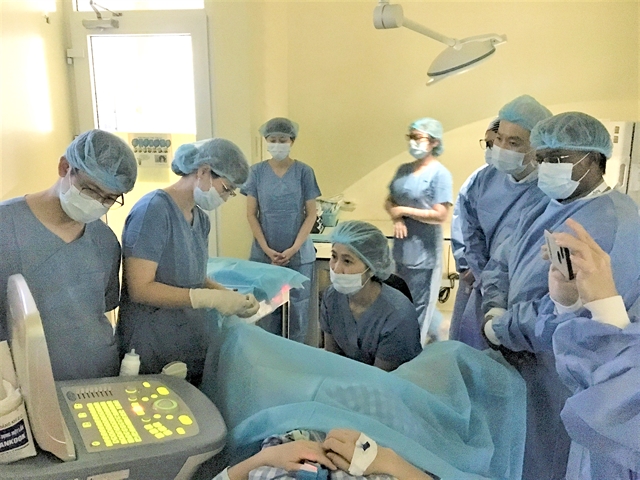 Society
Society

Vương Thi Ngọc Lan, a specialist at the HCM City University of Medicine and Pharmacy, has brought hope to thousands of infertile couples in Việt Nam through a study about the efficiency between the transfer of fresh or frozen embryos in women without polycystic ovaries for in vitro fertilisation (IVF).

|
| Vương Thi Ngọc Lan perfoms egg retrieval, a step used for IVF, to show foreign trainees. — Photos courtesy of Vương Thị Ngọc Lan |
HCM CITY — Vương Thị Ngọc Lan, a specialist at the HCM City University of Medicine and Pharmacy, has brought hope to thousands of infertile couples in Việt Nam through a study about the efficiency between the transfer of fresh or frozen embryos in women without polycystic ovaries for in vitro fertilisation (IVF).
It shows that the transfer of frozen embryos yielded similar results to fresh ones, and the research has helped doctors and patients make better choices and increase the chance of success of IVF while reducing complications.
Lan, 49, is among three scientists nominated for the 2020 Tạ Quang Bửu Award.
“I’m happy to be nominated for the award because it acknowledges scientists' efforts and successes,” she told Việt Nam News.
Her research paper was published by the New England Journal of Medicine in 2018.
The findings were concluded after Lan and her colleagues had randomly studied 782 infertile women without polycystic ovary syndrome who had undergone IVF.
The research proved that it was not necessary to transfer all fresh embryos but freeze them and transfer only one embryo per cycle. The method would reduce the risk of ovarian stimulation as well as multiple pregnancies.
The research suggested frozen embryo transfer shouldn’t be used for all IVF cases because it cost more money and lengthened the treatment period.
The transfer of frozen embryos should be applied for women who are at risk of ovarian hyperstimulation syndrome to reach a higher rate of success.
According to Lan, choosing the right method of embryo transfer was a problem that doctors at IVF centres around the world and Việt Nam faced every day.
In the past, when performing IVF, the transfer of fresh embryos was used for most patients and many embryos were transferred at the same time, leading to the risk of ovarian hyperstimulation and multiple pregnancies.
Then, in 2011, after the embryo freezing technique was improved, many IVF centres around the world switched to freezing whole embryos and transferring them to patients.
In Việt Nam, it is estimated that about 30,000 women seek IVF treatment each year.
The research paper gave doctors and patients clear answers on whether they should transfer fresh embryos or frozen ones for the most effective treatment, according to Lan.
Her whole career has been associated with the development of IVF in Việt Nam. In 1997, when she graduated from Phạm Ngọc Thạch Medical University, Lan volunteered to assist her mother, former director of Từ Dũ Hospital in HCM City, and pioneer the IVF technique in Việt Nam.
To help her mother, she took records and monitored patients.
At that time, a team of experts from France came to Việt Nam to support the first IVF cases. Lan was chosen to be one of the first Vietnamese doctors involved in the team to perform IVF thanks to her careful, meticulous and prudent work.
One of the first three babies who was born in 1998 thanks to IVF was named after her and Hồ Mạnh Tường (also a team member who later become her husband) – Phạm Tường Lan Thy – as thanks from a young couple, Lan recalled.
“My colleagues and I are moved to tears whenever we see families bursting with joy as they welcome their children. That is also the motivation for me to continue my efforts and support infertile couples to fulfill their wishes of having children,” she said.
In the beginning, facing difficulties and a low rate of pregnancy success (15 per cent), Lan and her colleagues had many sleepless nights.
“My heart hurt when I saw couples who had raised their hopes only to be disappointed. Some even broke up after several unsuccessful IVF attempts.”
The failures did not put her or the other doctors at Từ Dũ Hospital down, but encouraged them to try even harder.
There were times that Lan and her husband spent the whole day at the hospital to find the optimal method of IVF to gradually increase the success rate, bringing good news to infertile couples.
Over the past 20 years, they have directly treated more than 20,000 infertile couples. Thus, Lan is called by many people "the mother of thousands of children".
In 1998, she was presented the Kovalevskaya Award for the first IVF project in Việt Nam. In 2017, she was voted by Forbes magazine as one of the 50 most influential women in the country.
Sharing her experience, Lan said it took her a year to write, edit the research paper and fulfill the requirements for the journal, adding that it was revised 20 times.
However, she still feels lucky as thousands of articles from around the world are sent to the journal every week, and only 5 per cent of submissions are published.
“It's been a long and interesting journey. The most important thing is that my colleagues and I have gained valuable experiences for our next research project,” Lan said.
In the Asia Pacific region, Việt Nam is among the countries with the lowest fertility rates and highest infertility rates.
A study of more than 14,300 couples aged 15 to 49 in eight provinces and cities by the National Hospital of Obstetrics and Gynecology and the Hà Nội University of Pharmacy in 2015 showed that the infertility rate in the country stood at 7.7 per cent, while the global rate was 6-12 per cent. — VNS